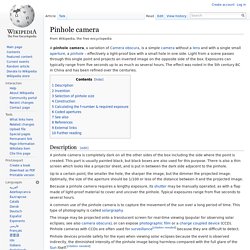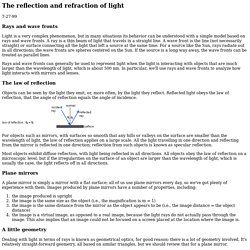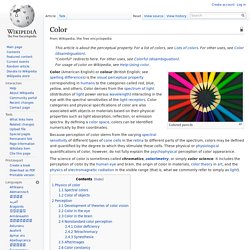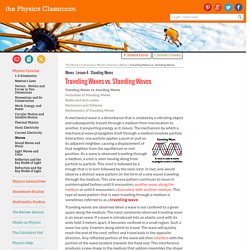

Pinhole camera. Description[edit] A pinhole camera is completely dark on all the other sides of the box including the side where the point is created.

This part is usually painted black, but black boxes are also used for this purpose. There is also a thin screen which looks like a projector sheet, and is put in between the dark side adjacent to the pinhole. Virtual Images. Pinhole.pdf. The reflection and refraction of light. Rays and wave fronts Light is a very complex phenomenon, but in many situations its behavior can be understood with a simple model based on rays and wave fronts.

Dispersion of Light by Prisms. In the Light and Color unit of The Physics Classroom Tutorial, the visible light spectrum was introduced and discussed.

Visible light, also known as white light, consists of a collection of component colors. These colors are often observed as light passes through a triangular prism. Ray Diagrams - Concave Mirrors. The theme of this unit has been that we see an object because light from the object travels to our eyes as we sight along a line at the object.

Similarly, we see an image of an object because light from the object reflects off a mirror and travel to our eyes as we sight at the image location of the object. From these two basic premises, we have defined the image location as the location in space where light appears to diverge from. Ray diagrams have been a valuable tool for determining the path taken by light from the object to the mirror to our eyes. In this section of Lesson 3, we will investigate the method for drawing ray diagrams for objects placed at various locations in front of a concave mirror. To draw these diagrams, we will have to recall the two rules of reflection for concave mirrors:
Light. Reflection - Refraction - Transmission. Exploring Light: Absorb, Reflect, Transmit or Refract? Each TeachEngineering lesson or activity is correlated to one or more K-12 science, technology, engineering or math (STEM) educational standards.

All 100,000+ K-12 STEM standards covered in TeachEngineering are collected, maintained and packaged by the Achievement Standard Network (ASN), a project of JES & Co. (www.jesandco.org). In the ASN, standards are hierarchically structured: first by source; e.g., by state; within source by type; e.g., science or mathematics; within type by subtype, then by grade, etc. Click on the standard groupings to explore this hierarchy as it applies to this document.
Learning Objectives After this activity, students should be able to: Explain the properties of light as related to security systems. This activity also meets the following Tennessee Foundations of Technology educational technology content standards: 2.0, 3.0, 4.0, 5.0, 6.0, 7.0 and 8.0; see Introduction/Motivation Assessment Activity Embedded Assessment Post-Activity Assessment Activity Extensions. Chapter7_Color. Color. Color (American English) or colour (British English; see spelling differences) is the visual perceptual property corresponding in humans to the categories called red, blue, yellow, and others.

Color derives from the spectrum of light (distribution of light power versus wavelength) interacting in the eye with the spectral sensitivities of the light receptors. Color categories and physical specifications of color are also associated with objects or materials based on their physical properties such as light absorption, reflection, or emission spectra. By defining a color space, colors can be identified numerically by their coordinates.
The Physics of Color - the Color Wheel and Color Spectrum. There are numerous webpages that describe these things in detail, so I will keep it short.

Most of the physical properties of colors are things that you can do without knowing. Learning about this certainly won't hurt, but skipping over them shouldn't affect your ability to use colors in an effective way. Technically speaking, colors are the way our brain, by use of our eyes, interprets electromagnetic radiation of a wavelenght within the visible spectrum. Visible light lies between 400 and 700 nanometers. Color. It is common practice to define pure colors in terms of the wavelengths of light as shown. This works well for spectral colors but it is found that many different combinations of light wavelengths can produce the same perception of color. This progression from left to right is from long wavelength to short wavelength, and from low frequency to high frequency light. The wavelengths are commonly expressed in nanometers (1 nm = 10-9 m).
The visible spectrum is roughly from 700 nm (red end) to 400 nm (violet end). The Doppler Effect. Sound is a Pressure Wave. Sound is a mechanical wave that results from the back and forth vibration of the particles of the medium through which the sound wave is moving.

If a sound wave is moving from left to right through air, then particles of air will be displaced both rightward and leftward as the energy of the sound wave passes through it. The motion of the particles is parallel (and anti-parallel) to the direction of the energy transport. This is what characterizes sound waves in air as longitudinal waves. Compressions and Rarefactions. Traveling Waves vs. Standing Waves. A mechanical wave is a disturbance that is created by a vibrating object and subsequently travels through a medium from one location to another, transporting energy as it moves.

Intensity and the Decibel Scale. Sound waves are introduced into a medium by the vibration of an object.

For example, a vibrating guitar string forces surrounding air molecules to be compressed and expanded, creating a pressure disturbance. OpenStax CNX - Content Library. Lesson 44: Frequency, Wavelength, & Amplitude. Now that you know something about the properties of the two main types of waves (Lesson 43), we need to make sure that you can look at individual characteristics that waves can have.
Not all waves are created equal! You need to be able to see the specific “faces” that each wave can have, based on three important characteristics: frequency, wavelength, and amplitude. Frequency When we first started looking at SHM we defined period as the amount of time it takes for one cycle to complete... seconds per cycle Frequency is the same sort of idea, except we’re just going to flip things around. Since frequency and period are exact inverses of each other, there is a very basic pair of formulas you can use to calculate one if you know the other… It is very easy to do these calculations on calculators using the x-1 button.